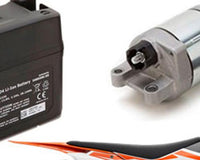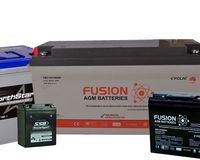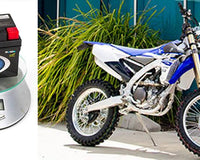Table of Contents
Just as your fuel tank can run empty at the wrong time or place, your battery can also die without warning — this is just one of the many realities of being a car owner.
A dead battery presents a slightly worse situation than an empty petrol tank (which can be replenished by a quick walk to the nearest station), which is why most people keep a pair of jumper cables (or jump leads) in their boot.
In the event that your battery does give out, a jump start may be your only option, short of calling a tow truck service.
To make sure you’re prepared for your next drive, we’ve put together eight useful tips to help you get back on the road if the day comes when your battery does give out.
Tip 1 - Perform A Safety Pre-Check Inspection First
First things first: check that the donor car’s engine isn’t running. The terminal-to-lug clipping (referenced in tip 2 below) has to be done with both engines off.
You also need to ensure that both cars’ gears are set appropriately. Automatic vehicles should strictly be in park, while manual vehicles can be set to neutral.
If you happen to have it on you, make a point of skimming through your battery’s user manual.
Unlike older vehicles, where contact is made directly to the battery terminals, most modern cars come with small lugs where the jumper cables can be attached.
Next, you need to establish the precise location of both batteries and then visually assess the physical condition of the unresponsive one.
Is there anything noticeably off with it? Can you spot any debris or grime on the terminals?
If so, clean these out first before clipping anything. Use a dry cloth to dust the terminals thoroughly, and check that they are fixed firmly to the battery lugs.
If you notice any conspicuous dents or chippings, it’s possible that your terminals are corroded to the point of short-circuiting.
Tip 2 - Focus On The Positives and Negatives

Once the pre-check is done, it’s time to unwind your cables. As a general rule, choose shorter cables.
While it is true that a longer cable offers more leeway into the bonnet of the unresponsive car, this isn’t all you should care about.
A longer cable increases the amount of energy that’s lost between the donor battery and the unresponsive battery, which means more current is wasted and more time has to be spent charging.
Use a shorter, thicker cable that’s no more than 10 feet long, as these tend to be reinforced with better insulation material.
Just before clipping, make sure to note which terminal is positive and which is negative, both on the cables AND on the battery lugs. Positive terminals are indicated by a plus sign (+) and red plastic cabling, while negative terminals are indicated by a minus sign (-) and black cabling.
It’s important that you do this correctly as jump starting an engine whose battery connections are mismatched can permanently damage your vehicle’s circuitry.
| Connection | Positive Lead | Negative Lead |
| Positive Lug | ✓ | ❌ |
| Negative Lug | ❌ | ✓ |
Tip 3 - Rev The Donor’s Car To At Least 3000 RPM
Once the clipping has been done properly, switch on the donor’s car engine and let it run at its normal pace.
After five minutes or so, begin to rev its engine ever so slightly, keeping it at 3000 RPM or thereabouts. For the average engine, this shouldn’t be any faster than normal. For turbocharged vehicles, you might have to get it to 5000 RPM.
By doing this, the donor battery’s alternator replaces any lost voltage and gives the faulty battery a better starting jolt. Barring any other issues, the car with the unresponsive battery should start up immediately.
Give it at least ten minutes or so to draw a full charge, more so if you’re heavy on accessories (alarm system, alternator, and radio).
If you’re still out of luck 20 minutes (utmost 30) into the charge, then the problem might not be with your battery. At this point, you may be well-advised to call a towing service.
Tip 4 - Carefully Remove The Cables, In Order
Once your battery is up and running again, turn off both engines. This will cut off any current running either to or from the batteries.
Carefully unclip the jumper cables in the right order: begin with the negative terminal of the previously unresponsive battery and then unclip the donor car’s terminal, and repeat this process for the positive terminals.
IMPORTANT: To prevent sparking, none of the terminals should touch each other as you remove them. Keep them a safe distance apart until they are safely inside their toolbox.
Just before you store them safely away, though, make sure to inspect the jump leads for any damage. If they are durably designed cables they should be intact.
If not, discard them and invest in thicker (probably more expensive) cables that are designed with high-grade copper.
Frequently Asked Questions

Is it possible to jump start your car alone, without the use of another car’s battery?
Yes, you can. While the easiest way to fix an unresponsive battery is to use another car’s battery to jump start yours, it is possible to get back on the road without its help.
You can force-start your car by pushing it forward while in neutral. Most batteries will self-start once the car clocks 5 MPH thereabout, provided you have the ignition on before starting the push.
Is it possible to jump start a car that uses automatic transmission?
Yes, you can. Jump starting an automatic-transmission vehicle works in the same way as manual transmission vehicles, and the same goes for the cable connection mechanism across both transmissions.
The only difference is that you can’t force-start an automatic car’s battery by pushing it as you can a manual vehicle.
Is it possible to jump start a diesel-fuelled car with one that uses petrol (and vice-versa)?
Yes, you can. Though in the olden days of standard fuel pumps it wasn’t recommended, it is generally okay to jump start a car that uses a different type of fuel.
That said, you do need to make sure that both batteries’ voltages are the same before the jump start to prevent the risk of damaging either of them.
All in all, remember to check that:
- Both cars are parked close enough to each other—enough for both ends of the jumper cables to span comfortably.
- The helper car’s engine is off before the jump start and your safety goggles (and polyester gloves) are on.
- All accessories are unplugged before the jump start—chargers, radio, or cigar lighters. If you don’t do this you risk a short circuit.
- Confirm that both cars’ voltages match up perfectly. This is important; a voltage mismatch can cause permanent damage to both vehicles.
And make sure NOT to:
- Perform the jump start if you even suspect either battery to be leaking, or its fluid to be frozen—this can result in an explosion.
- Bring any metallic ornaments near the terminals—remove any rings or bracelets from your forearm.
- Lean too close to the battery before, during, or after the jump start—to reduce any risk in case of a spark or explosion.
- Smoke, light or ignite anything anywhere near the scene of the jump start.
HBPlus Battery Specialists: Experts in All Things Power

Experts? In all things power? Pretty grand claims we make for ourselves, you say.
Well, not exactly. For starters, we’re Australia's largest volume distributor of Duracell and Duracell Procell dry cell bulk batteries.
See, at HBPlus Battery Specialists, our driving mantra is efficiency.
We design, manufacture, and distribute a wide selection of batteries, as well as provide services for all of your battery requirements, from the smallest orders to the largest.
With our Carrum Downs warehouse in Victoria, we can refurbish and re-pack batteries on-site, providing quality service at a reasonable cost.
We’ve done so for enough years now that we’ve gathered something of a reputation amongst Australia’s automotive enthusiasts. Here’s what our customers have had to say about our service:
"I can highly recommend The Battery Specialists. Both for quality batteries and excellent service. I will be buying again from them."
– Paul D. Bundaberg.
"No stock when ordered. But had a phone call a couple of days later to say that they are on the way. Service is beyond what I expected and I would recommend you give them a try."
– Dave T.
"Recently purchased a somewhat hard-to-get battery from HBPlus. Delivery was very timely and even had a phone call to advise of a short delay in communication which is rare for even some much larger companies."
– Bruce M.










